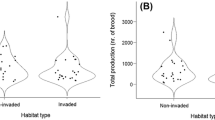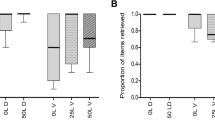Summary
To ascertain what factors affect reproductive output of colonies of the Desert Harvester Ant, Pogonomyrmex desertorum, colonies were subjected to two experiments. The first was a 3-way factorial design, which varied (i) artificial predation intensity, (ii) seed addition, and (iii) insect matter addition. The second experiment used fences to prevent horned lizards (Phrynosoma spp.) from foraging on concentrations of worker ants found at colony entrances. Increased artificial predation caused a decrease in alate production. The effect of predation was strongest in colonies also receiving insect matter. The treatments of adding seeds and adding insect matter by themselves did not have a measurable effect on alate production. Exclusion of horned lizard predators using fencing also had no effect on alate production. Although this study shows that predation has the potential to affect reproductive output (and therefore the potential to have been important in the evolutionary history of P. desertorum) the present study shows no evidence that either present levels of predation or scarcity of food limit reproductive output.
Similar content being viewed by others
References
Brown JH, Davidson DW, Munger JC, Inouye RS (1986) Experimental community ecology: the desert granivore system. In: Diamond J, Case TJ (eds) Community Ecology. Harper and Row, New York, pp 41–62
Brown JH, Munger JC (1985) Experimental manipulation of a desert rodent community: food addition and species removal. Ecology 66: 1545–1563
Carlson D, Gentry J (1973) Effects of shading on the migratory behavior of the Florida harvester ant, Pogonomyrmex badius. Ecology 54: 452–453
Davidson DW (1977) Foraging ecology and community organization in desert seedeating ants. Ecology 58: 711–724
Davidson DW (1982) Sexual selection in harvester ants (Hymenoptera: Formicidae: Pogonomyrmex). Behav Ecol Sociobiol 10: 245–250
Davidson DW, Samson DA, Inouye RS (1985) Granivory in the Chihuahuan Desert: interactions within and between trophic levels. Ecology 66: 486–502
Gentry JB (1974) Response to predation by colonies of the Florida harvester ant, Pogonomyrmex badius. Ecology 55: 1328–1338
Hansen SR (1978) Resource utilization and coexistence of three species of Pogonomyrmex ants in an upper Sonoran grassland community. Oecologia 35: 109–117
Hölldobler B (1976) Recruitment behavior, home range orientation, and territoriality in harvester ants, Pogonomyrmex. Behav Ecol Sociobiol 1: 405–423
Hölldobler B, Wilson EO (1990) The Ants. Harvard Univ. Press, Cambridge, MA, USA
Hurlbert SH (1984) Pseudoreplication and the design of ecological field experiments. Ecol Monogr 54: 187–211
Lee SH (1957) The life cycle of Skrjabinoptera phrynosoma (Ortlepp) Schultz, 1927 (Nematoda: Spiruroidea), a gastric nematode of Texas horned toads, Phrynosoma cornutum. J Parasit 43: 66–75
MacKay WP, MacKay EE (1984) Why do harvester ants store seeds in their nests? Sociobiology 9: 31–47
Munger JC (1984a) Long-term yield from harvester ant colonies: implications for horned lizard foraging strategy. Ecology 65: 1077–1086
Munger JC (1984b) Optimal foraging? Patch use by horned lizards (Iguanidae: Phrynosoma). Am Natur 123: 654–680
Munger JC (1986) Rate of death due to predation for two species of horned lizard, Phrynosoma cornutum and P. modestum. Copeia 1986: 820–824
Oster GF, Wilson EO (1978) Caste and ecology in the social insects. Princeton University Press, Princeton, NJ, USA
SAS (1985) SAS User's Guide: Statistics. Vers. 5. SAS Inst., Cary, NC, USA
Whitford WG, Bryant M (1979) Behavior of a predator and its prey: the horned lizard (Phrynosoma cornutum) and harvester ants (Pogonomyrmex spp.). Ecology 60: 686–694
Whitford WG, Ettershank G (1975) Factors affecting foraging activity in Chihuahuan desert harvester ants. Environ Entomol 4: 689–696
Author information
Authors and Affiliations
Rights and permissions
About this article
Cite this article
Munger, J.C. Reproductive potential of colonies of desert harvester ants (Pogonomyrmex desertorum): effects of predation and food. Oecologia 90, 276–282 (1992). https://doi.org/10.1007/BF00317186
Received:
Accepted:
Issue Date:
DOI: https://doi.org/10.1007/BF00317186




